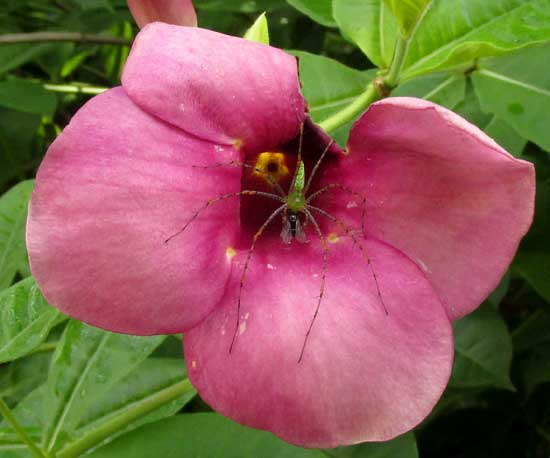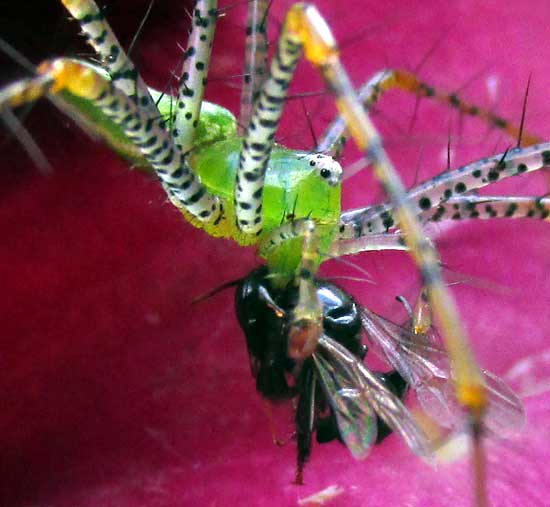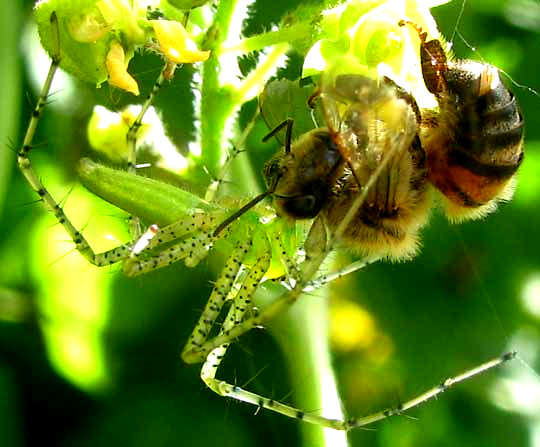Excerpts from Jim Conrad's
Naturalist Newsletter
from the August 9, 2018 Newsletter issued from Rancho Regenesis in the woods ±4kms west of Ek Balam Ruins, central Yucatán, MÉXICO
GREEN LYNX AT THE BLOSSOM'S DOOR
This week as I was admiring our Purple Allamanda's blossoms, a Green Lynx turned up in a classic position, shown below:

In that picture you can see that the lynx has caught something. A closer look is shown below:

Green Lynxes are common here, with several in the garden, often seen on the same plant day after day.
from the December 18, 2011 Newsletter issued from Hacienda Chichen Resort beside Chichén Itzá Ruins, central Yucatán, MÉXICO
DO SPIDERS EAT HONEYBEES?
If you've ever wondered about that -- since it would seem that honeybees might defend themselves -- look below.

The spider looks like the Green Lynx spider, PEUCETIA VIRIDANS, the same species found in the US southern states from coast to coast, south through Mexico, the Caribbean, into Central America. In the picture the bee has strands of spider silk adhering. Either that silk belongs to another spider species or it's the Lynx's dragline, because Green Lynxes don't make webs, just trail silk draglines, even when jumping.
Green Lynxes are among the most commonly encountered and successfully hunting of spiders in our area, ranging over vegetation like wolves (or lynxes) through the woods. They're important predators of both insects that damage plants and pollinators the plants need.
from the August 1, 2004 Newsletter issued from the woods near Natchez, Mississippi, USA
GREEN LYNX ON A RAGWEED
One of the most eye-catching discoveries this week was a fairly large, green spider (front feet to back feet 1¼ inches, 3.2 cm) known as the Green Lynx, PEUCETIA VIRIDANS. Green Lynxes, instead of producing webs, roam over vegetation or lie in wait and leap on prey. Technically they're not wolf spiders. Wolf spiders are members of the Wolf Spider family, the Lycosidae, and mostly hunt on the ground, though some may go into vegetation. Lynx spiders have their own family, the Oxyopidae, and typically hunt in vegetation. The 350 or so species in the Lynx Spider Family are mostly tropical but about 20 species occur north of Mexico. Among the northern species our Green Lynx is the most conspicuous and best known, though it's found only in the southern states. This is such a spectacular spider that hobbyists often keep them in terrariums.
Despite not building webs, Green Lynxes do produce silk, but they use it as draglines as they hunt -- so that if they fall from a leaf, they'll end up dangling at the end of their dragline and can quickly return to their position. Also their egg sacs are made of silk, and silk is used to anchor the egg sacs to plants. The female then guards the egg sac.
My Green Lynx stayed on the same ragweed leaf for three days, then disappeared. That clump of ragweeds also is home for two rapidly growing baby Green Anoles, so maybe that explains the spider's disappearance. You really deny yourself a good bit of drama in your life when you cut down a ragweed!